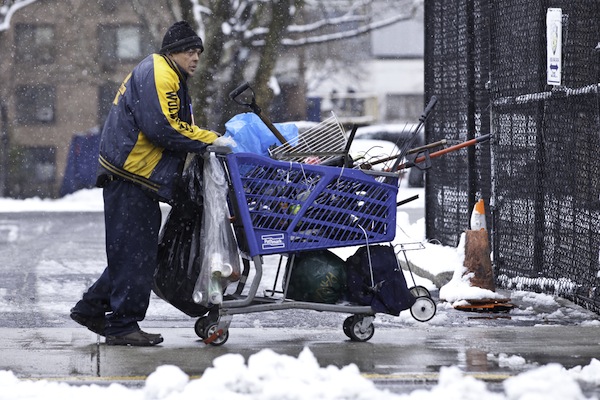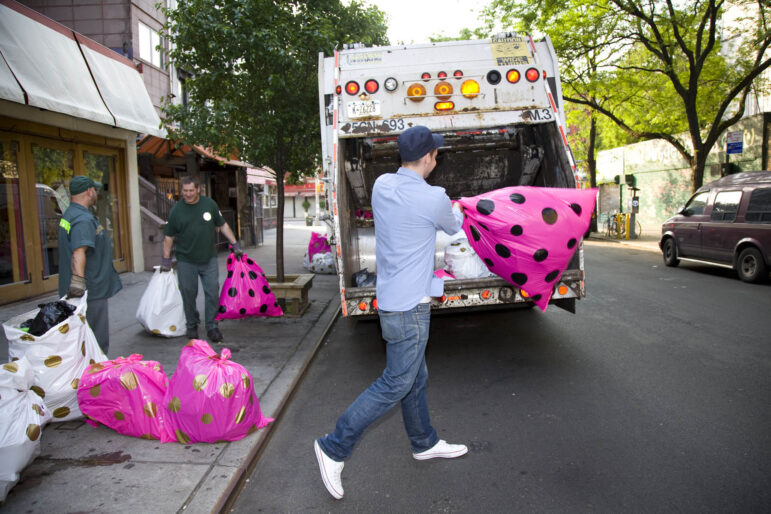
Photo by: Taleen Dersdepanian
Santos Ramos, a homeless man on the street, represents the more visible but less common form of homelessness. The city counts only a few thousand people living on the streets, but nearly 50,000—many in families—living in shelters.
On the morning of December 31, while most New Yorkers were gearing up for the evening’s festivities, Monica had other things to worry about.
The day before, the 30-year-old Connecticut native had been out visiting her sister in her Bronx apartment. She had wanted to stay over for dinner but couldn’t miss the nine o’clock curfew of the emergency shelter she was staying at with her three-year-old daughter. As she was signing back in, the shelter officer on duty handed her a letter.
The document, she knew all too well, wouldn’t bring the kind of news she had hoped the New Year would bring. She recognized the two sheets of paper stapled together. It was the Department of Homeless Services, informing her that she had been found “ineligible.” In other words, her application to leave the emergency facility and enter the city’s crowded shelter system had been denied again.
The following morning Monica put her daughter in a stroller, covered her with a blanket and headed out to seek shelter. This was the fourth time in less than two months that she had to make the short trip to the city’s intake center for homeless families, the Prevention Assistance and Temporary Housing—better known as PATH .
Once again, after hours of waiting on the seven-story building’s first floor, she was told she hadn’t provided sufficient proof that she had nowhere else to go. And once again, she would have to reapply, go back to the emergency shelter where she was temporarily staying and hope for a luckier outcome.
She decided to stop by McDonald’s to grab a warm cup of coffee. Located on 151 Street and Grand Concourse, only two blocks from the PATH intake center, other homeless families were there for a break. PATH provides families with food and water, but many who visit the intake center like to make a stop for something more substantial before heading back to whichever shelter they call home.
Except for the suitcases, one couldn’t tell the difference between the homeless people and other customers. But for those who were homeless, it seemed like the definition of family had expanded to embrace just about anyone who had pushed the front doors of the intake center on this last day of the year, perhaps even all 47,000 people who found themselves somewhere in the city’s shelter system that evening. Across the restaurant room, parents who sometimes looked no older than 18 exchanged information on their pending statuses, while children shared toys over a Happy Meal.
Nine years ago, reacting to the city’s stubbornly-high and increasing homeless population, Mayor Bloomberg delivered a speech in front of a packed audience of service providers, city officials and other advocates working in the field of homelessness. The occasion was the unveiling of a plan to cut the then 37,000-strong homeless population by two thirds in five years. Contrary to that plan, at the McDonald’s near the PATH center, the flow of suitcases going in and out during the mayor’s last year in office doesn’t show any sign of dwindling.
Average daily census, NYC homeless shelters
A bold promise
In Uniting for Solutions Beyond Shelter, the plan the mayor unveiled in 2004, Bloomberg set his administration numerous goals—60 overall—that would tackle all aspects of the homeless issue and reduce the city’s shelter population to about 12,300 people.
Key initiatives included the creation of a community-based homeless prevention program to help tenants on the brink of losing their homes, a campaign to reach out to the most vulnerable population of homeless individuals sleeping in the streets and the rapid re-housing of shelter residents in permanent housing. Shelter services would also be improved and the Emergency Assistance Unit, the city’s notoriously dysfunctional family intake center, would be replaced by a more efficient building.
“We have to recognize the costs, and failings, of our own best intentions,” the mayor said. “Because in addressing homelessness, we’ve focused on crisis management rather than on identifying and pursuing long-range solutions.”
At the center of the mayor’s plan was a determination to stop the cash hemorrhage that had been crippling the Department of Homeless Services for years. Each year the agency would spend hundreds of millions of dollars on shelters—$600 million in 2004—an expensive and inefficient way of combating homelessness. The only way to achieve this paradigm shift was to channel some of this money into homeless prevention and other long-term housing solutions.
“Let me tell you something,” Bloomberg said to the packed crowd in front of him. “We are too strong, and too smart, and too compassionate a city to surrender to the scourge of homelessness. We won’t do it. We won’t allow it.”
Before reaching today’s historically high numbers—48,461 were in the shelters as of last Wednesday, March 6—the homelessness numbers did decrease. Within the first year of the plan’s implementation, the shelter census fell from 38,136 individuals to 33,295. Considering that the shelter population had been on a constant rise since the late 1990s, this was a meaningful improvement. The census numbers then continued to decline through 2006. In June, on the second anniversary of the unveiling of the plan, the census hit its lowest point, with 31,284 individuals and families sleeping in the city’s shelters. While far from the goal of a two-thirds reduction, this 18 percent drop was full of hopes and promises. Then, 2007 happened. The housing bubble burst, along with the hopes that Bloomberg’s plan would ever go as predicted. Between 2007 and 2010 nearly 90,000 households in the city filed for foreclosures. What had started as an unforgiving housing crisis expanded into the long and painful recession that many are still waiting to recover from.
Annual one-night survey of street homeless
Undoubtedly, poverty and homelessness soared as a result of the economy, and the consequent diminution in available funding. But while Bloomberg and other DHS officials have often blamed the economy—or at times, the comfort of shelters—for the failure to meet their 2004 goal, the administration’s early enthusiasm seems to have been lost somewhere along the way. In the final chapter of his tenure, Bloomberg and the Department of Homeless Services appear worn out on the issue, maybe downhearted by the size of the problem. A sense of helplessness has grown where there was once a hint of notable successes. For all the brash ambition in the mayor’s final state of the city speech in February, homelessness didn’t merit a mention. More than ever, it’s back to crisis management. And the people running to succeed Bloomberg have offered little to suggest they will turn the page.
Read this five part series.









